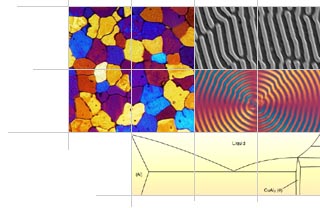Micrograph Library
Browse the libraryAdvanced searchSystemsCompositionsTechniquesKeywordsPhase diagramsHelpPreferencesAbout the micrograph libraryTerms of useContribute micrographs!FeedbackLinksCredits Print this page

Full Record for Micrograph 614

[69 KB]
View micrograph
.. in new window
View micrograph and record
.. in new window
You can also view and download the micrographs on Flickr
- Micrograph no
- 614
- Brief description
- Rapid solidification in an atomised droplet
- Keywords
- alloy
 , atomising
, atomising  , droplet, hypercooled, latent heat
, droplet, hypercooled, latent heat  , metal, rapid solidification, recalescence, soldidification
, metal, rapid solidification, recalescence, soldidification - Categories
- Metal or alloy
- System
- Al-Mg

- Composition
- Al 90, Mg 10 (wt%)
- Standard codes
- Reaction
- N/A
- Processing
- Rapid solidification of an atomised droplet
- Applications
- Rapid solidification processing reduces the scale of microsegregation and increases solid solubility (allowing subsequent fine-scale precipitation). 'Glassy' (vitrified) metals can be produced.
- Sample preparation
- Technique
- Transmission electron microscopy (TEM)
- Length bar
- 500 nm
- Further information
- Because of the fine scale of the droplet, heat extraction is very rapid, and large undercoolings are achieved before crystal nucleation can begin. Thus, in this droplet, the solidification front has advanced very rapidly through the droplet from the nucleation point (on the surface at the left of the image). Its velocity is initially so great that no interfacial breakdown is possible. As the front advances, however, latent heat is evolved and this 'recalescence' reduces the rate of solidification to a point where interfacial breakdown is possible and a cellular structure is observed in the last region to solidify (at the right hand side of the image).
- Contributor
- Prof T W Clyne
- Organisation
- Department of Materials Science and Metallurgy, University of Cambridge
- Date
- 03/10/02
- Licence for re-use
 Attribution-NonCommercial-ShareAlike 4.0 International
Attribution-NonCommercial-ShareAlike 4.0 International

